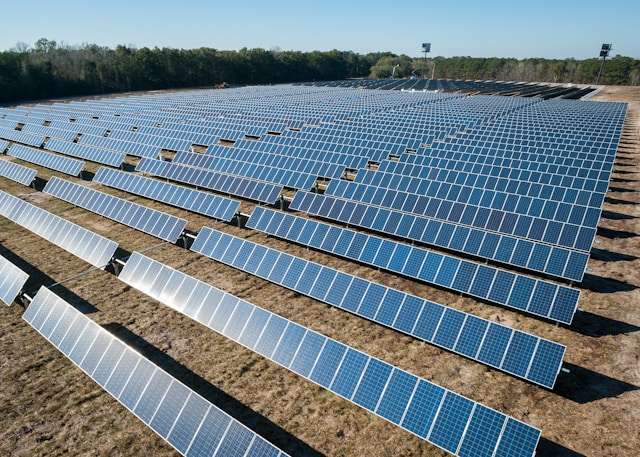Are you exploring solar energy but hesitant about rooftop installations? Ground mounted solar panels might be your answer! This comprehensive guide dives into why these systems are gaining traction, how they work, and how they can empower your journey toward energy independence. Let’s unlock the potential of solar power—right from your backyard!

Understanding Ground Mounted Solar Panels
Think of ground mounted solar panels as sunlight harvesters rooted in your property. Unlike rooftop systems, these panels are secured to the ground using durable frames, positioned to capture every possible ray. Perfect for open spaces, they’re ideal if your roof isn’t suitable or you crave flexibility.
Two Primary Configurations:
- Fixed-Angle Systems: Permanently tilted for optimal sun exposure based on your location.
- Solar Tracking Systems: Dynamic setups that pivot with the sun’s path, boosting energy yield by up to 25%.
Customization is key here. Adjust heights, angles, or layouts to suit your land and energy goals—options rarely possible with rooftop arrays.
Top Reasons to Opt for Ground Mounted Solar Panels
- Roof Compatibility Issues Solved
Homes with shaded, aging, or steep roofs benefit immensely. Ground systems bypass structural concerns, letting you leverage unused land instead. - Peak Performance
With ideal positioning and minimal shading, ground setups often outperform rooftop panels. More sun exposure equals higher energy production and faster ROI. - Effortless Upkeep
Say goodbye to precarious rooftop climbs! Ground-level access simplifies cleaning, inspections, and repairs. - Scalability for Future Needs
Expanding your system? Ground arrays allow seamless additions, adapting to growing energy demands or tech upgrades. - Preserve Your Roof’s Integrity
Avoid drilling or weight stress on your home. Ground installations keep rooftops pristine and maintenance-free. - Sun-Tracking Technology
Invest in tracking systems for unmatched efficiency. Though pricier, they maximize output, ideal for sun-rich regions.
Installing Ground Mounted Solar Panels: A Roadmap
Phase 1: Site Assessment
Identify a sunny, unobstructed area—south-facing spots are prime. Consider soil type, drainage, and local wildlife to avoid future issues.
Phase 2: Energy Audit
Review past utility bills to gauge your household’s consumption. This determines panel quantity and system size.
Phase 3: Choose Your System
Fixed systems are budget-friendly, while trackers offer premium efficiency. Balance upfront costs with long-term gains.
Phase 4: Prep and Permits
Level the terrain and install mounting structures. Partner with certified installers for compliance with local zoning laws and permits—a critical but tedious step.
Phase 5: Installation & Activation
Once frames and panels are secured, connect wiring to inverters and your power grid. Professional installation ensures safety and efficiency.
Phase 6: Fine-Tuning
Optimize panel tilt (typically matching your latitude) or let trackers auto-adjust. Monitor performance via apps for real-time insights.
Cost Considerations
Ground mounted systems often cost 10-20% more than rooftop setups due to materials and labor. However, tax credits (like the U.S. federal ITC), rebates, and heightened efficiency can offset initial expenses. Over time, reduced energy bills and potential net metering credits enhance savings.
Potential Drawbacks
- Space Requirements: Larger yards or properties are ideal. Urban settings may lack adequate room.
- Aesthetic Impact: Some find panels disrupt landscaping. Creative screening with plants or fencing can help.
- Upfront Investment: Higher initial costs, though incentives and long-term savings mitigate this.
Are They Worth It?
For landowners prioritizing efficiency, scalability, and ease of maintenance, ground mounted solar panels are a stellar choice. They’re a long-term investment in sustainability, slashing carbon footprints while stabilizing energy costs.
Take the Next Step Toward Solar Independence
Ready to transform your property into a clean energy hub? Start by consulting solar experts, evaluating incentives, and designing a system tailored to your needs. With ground mounted solar panels, you’re not just saving money—you’re championing a greener future.
FAQ’s
- Q: Can ground mounted solar panels work in snowy or cold climates?
A: Absolutely! Ground mounted systems handle snow well, especially when tilted, as snow slides off more easily than on rooftops. They’re also easier to access for manual clearing. Plus, cold temperatures can improve panel efficiency slightly. - Q: How much land do I need for ground mounted solar panels?
A: A typical residential system requires 500–1,000 sq. ft. for a 5–10 kW setup, depending on panel spacing and tilt. Larger systems (e.g., 20 kW) may need 2,000+ sq. ft. Always consult an installer for site-specific assessments. - Q: Do ground mounted panels damage the soil or landscape?
A: Not significantly. Installers use non-invasive mounting techniques, and the area beneath panels can even support pollinator-friendly plants or grazing. For minimal disruption, opt for screw-in foundations instead of concrete. - Q: Are ground mounted solar panels prone to theft or vandalism?
A: While rare, securing your system is wise. Use lockable mounts, install motion-sensor lighting, or add fencing. Many homeowners also insure their solar installations against such risks. - Q: Can I combine ground mounted and rooftop solar panels?
A: Yes! Hybrid systems let you maximize energy production by utilizing both spaces. This is ideal if your roof has limited capacity but you want to scale up energy generation.